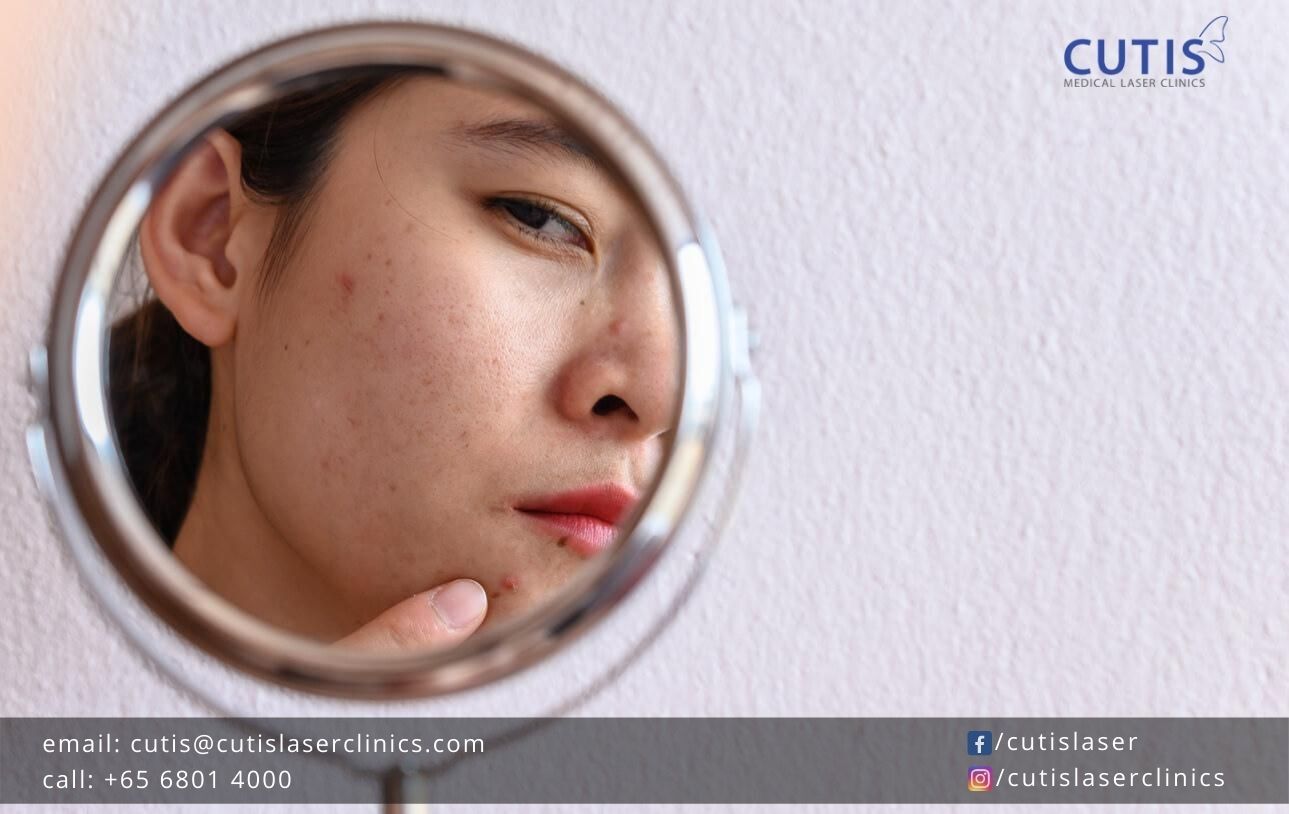Acne scars serve as a reminder of what your skin has gone through after breaking out. The sad part is just like acne, scarring can also take months (or even years) to heal or improve. There also cases where aesthetic procedures are needed to get rid of them completely and enjoy clear and smoother skin.

Acne scars vs acne marks
Acne scars are different from acne marks, but many people use both terms interchangeably. Scarring occurs as a result of deep trauma to the skin and takes in different forms such as the following:
- Ice pick scars – small, but deep pitted scars; make the skin look like it was punctured by an ice pick
- Rolling scars – have sloping edges and different depths; can make the skin look wavy
- Boxcar scars – broad skin depressions with defined edges
- Hypertrophic scars – elevated or raised scars
Acne marks, on the other hand, are temporary discoloration in the skin that occurs as a part of your body’s healing process. They leave a discolored patch on the skin, which can be brown, pink, or reddish. Marks are much easier to treat than scars, because they are flat and don’t affect the texture of the skin.
Common questions about acne scars/marks
If you suffer from acne scars and acne marks, it is only important to learn more about them. Continue reading to find the answers to common questions about acne scarring and pigmentation.
1. Are acne scars permanent?
No. While acne can leave lasting spots or pitted scars on your skin, they can improve over time. As time goes by, you may be able to see fading in some of your acne marks and reduced depth in your scars. The use of treatments and aesthetic procedures can improve their appearance, especially for marks and scars that linger too long.
2. Does picking or popping your pimples cause scars?
Yes. Doing so can only increase your risk of scarring or discoloration. In fact, picking, popping, and squeezing your pimples is among the habits that can make your acne scars worse. Plus, touching your face or a blemish can transfer bacteria from your hands to face. This can lead to inflammation and delay the healing process.
3. Do I need surgery to get rid of acne scars?
Acne scars affect people differently. Factors like genetics and the use of acne treatment can also affect its severity. Surgery is not necessarily required to remove acne scars, as there is a range of non-invasive and minimally invasive treatments that can improve their appearance. A consultation with an aesthetic doctor can help determine what’s right for you.
4. What can I do to remove or improve my acne scars?
Light marks or discoloration can fade on their own without treatment. This, however, is not necessarily the case for dark spots and indented scars. Aesthetic treatments can help improve their appearance as well as the overall condition of your skin.
At Cutis Laser Clinics in Singapore, we have a number of safe and effective treatments that can help with acne scarring and post-inflammatory hyperpigmentation. Here are some procedures that can help:
Microneedling (Dermapen 4) – This advanced microneedling system vertically pierces the skin, creating micro-trauma. This then prompts an immune response that leads to the creation of new collagen. Dermapen 4 can improve and treat scars, wrinkles, enlarged pores, and stretch marks.
Laser Skin Rejuvenation – This non-invasive treatment uses a laser handpiece that gently warms the skin’s surface. It can treat acne scars, rosacea, large pores, wrinkles, and uneven texture. Laser Skin Rejuvenation can stimulate cell growth and collagen production. It can also be combined with Dermapen and chemical peels.
Cutis Modified Jessner Peel – This stronger type of superficial-to-medium depth chemical peel is used on the face area only. It can treat acne scars and reduce pigmentation, age spots, and freckles. This peel is ideal for those with oily and acne-prone skin types.
Cutis TCA CROSS (Chemical Reconstruction of Skin Scars) – This is only used as a spot treatment for acne scars and contains a pure solution of 70% trichloroacetic acid. It can effectively treat deep ice pick or pitted scars and improve boxcar scars. It safely triggers an acid injury to the skin and induces collagen stimulation.
Skin Resurfacing – This non-invasive treatment treats the skin’s top layer with pulses of light in a pre-selected pattern. It can improve collagen production and give skin a “pearl-like” glow by treating both the dermis and epidermis layers. It can reduce the appearance of acne marks, wrinkles, and hyperpigmentation.
5. How can I prevent acne scars or reduce the chances of scarring?
To avoid scars and marks in the first place, it is best to treat active acne first. This means using the right acne medication or consulting a skin doctor for the right treatment. Getting to the root of the problem can help in getting spots and marks under control. Other things that can prevent scarring include:
- Wear sunscreen daily.
- Consider a topical retinoid or retinol.
- Avoid heavy makeup (when using makeup choose those labeled as non-comedogenic)
- Don’t scrub your skin or over exfoliate.
- Explore aesthetic treatments for banishing acne.
Win your battle against acne scars and spots with the right information. Contact Cutis Laser Clinics in Singapore today and schedule a consultation with our Harvard-trained aesthetic doctor, Dr. Sylvia Ramirez, to learn which acne scar treatment is right for you.
- If you would like to be an informed patient, please contact us at +65-6801-4000 or
hello@cutislaserclinics.com. - Cutis Medical Laser Clinics, 9 Scotts Road Pacific Plaza, Scotts Medical Center #08-07, Singapore – 228210
+65-6801-4000 - hello@cutislaserclinics.com
